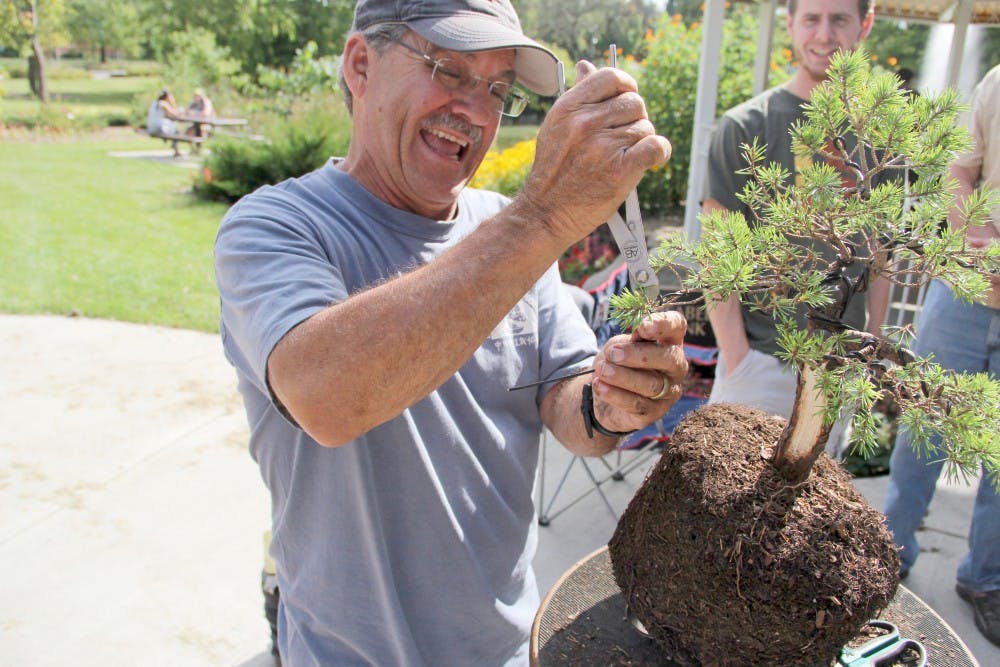Bonsai Club showcases trees

New member of the Bonsai club, Rod King, 66, fine wires a bonsai plant during the bonsai show at the Fabiano Botanical Gardens on Sept. 26, 2015.
The art of Bonsai has closer ties to Mount Pleasant than one may think.
Saturday Sept. 26 Central Michigan University's own Bonsai Club showcased their plants in the Fabiano Botanical Garden. The showcase included over 15 plants which the members used to give demonstrations on how to manipulate and trim the plants.
The Bonsai Club is not a registered student organization, it is a club open to all Mount Pleasant community members as well as Central Michigan University's faculty and students.
"The club originally started because of my elementary interest in Bonsai," said President of Bonsai Club Dan Koefoed. "I talked to Patti M. Travioli, who takes care of the Fabiano Gardens and Greenhouse, and we shared a common interest in the trees. Our first show was about four years ago, the founder of the Lansing Bonsai Club helped us out and people started showing interest right here in Mount Pleasant."
Bonsai is not just a small tree, it's the art of growing dwarfed ornamental varieties of trees or plants in small pots or trays by selectively trimming and shaping.
The showcase consisted of trees from all members of the club and students came to learn about what Bonsai is and how they can start growing in their apartments or dorms.
"To achieve a Bonsai tree you have to start with a regular tree," club member Rod King said. "In our climate, you can start out with a regular nursery plant and start trimming anywhere between fifty and eighty percent of the foliage on the tree. After that, you use wire to organize the branches the way you want them. I usually trim them once every year and let them rest before repotting them in Bonsai soil mixture. It's not difficult to keep up with these plants but you have to water them daily."
King has been practicing the art of Bonsai for about thirty years. Although it's an unusual hobby, the club is a way for him and others who share the same interests to come together and share ideas, see what is possible and get a feel for how different plants develop.
Most trees can become cultured in Bonsai, they just have to be conducive to reducing in size. Most people think of Juniper trees when they think of the art of Bonsai. Trees like Chinese Elms are also popular due to the smaller leaves, which can get even smaller once manipulated. Most of the plants are kept outside like regular trees, besides the tropical types, and go through a dormant period.
One technique that can be done to achieve an interesting look is preserving dead parts of the tree with lime sulfur. When limbs of the tree die and some prevail, the lime mixture will turn the tree white and preserve it from rotting. These are called "deadwood" trees.
Gladwin senior Nathan Kisther always had an interest in the Bonsai tree culture. He got in touch with Koefoed and joined the club when he found out about the opportunity.
"I have a few trees but it takes years to achieve Bonsai," Kisther said. "One Ginseng Ficus of mine was in the show and I also have a few Jade trees which are easier to care for because they're succulents. Over the summer, I rescued three trees from a gardening job and am currently training them to look a certain way. Training includes anything from trimming the roots to wiring the branches."
Bonsai trees are an art that is trying to replicate nature. There are trees out west that are shaped by nature and become dwarfs due to lack of nutrition, high winds or other causes. That type of natural beauty is exactly what these club members are trying to replicate with their trees.
"I once received a tree from a student and my main goal was to make sure it didn't die," said Gary Silker, a club member. "The tree is now twelve years old and I had to train is for about three years. It's branches were shaped like a 't' and I learned to start shaping it from a globe. I used to be afraid to trim the trees for fear that I might make a mistake, but after joining the club about three years ago, I've been doing pretty good."
The Bonsai Club is a way for it's members to get a small relief for the responsibilities life has to offer. They all come together to shape their trees, provide advice, and learn from one another.
"I've been a nature person my whole life," Koefoed said. "I also used to like building model planes when I was younger, so in a way making Bonsai really combines both aspects of nature and nurture. It's pretty awesome."




